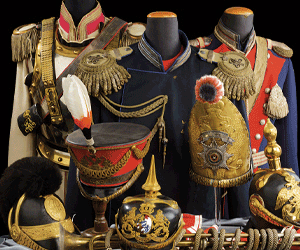Waffen-SS 2nd pattern Special Service Officers Stellengruppe Z Shoulder Boards
SKU: 50.GOR.01.03.02.01.02.02.003
Estimated market value:

Estimated market value:
Attributes
History
Waffen-SS shoulder boards were introduced in 1935 for NCO/EMs and in 1938 for Officers. They indicated the rank and service branch of the wearer. They closely follow the design of Wehrmacht shoulder boards, but with slight differences.
The shoulder boards of all Officer grades, excluding General Officers, started with a black base upon which a secondary layer in the appropriate service branch colour (Waffenfarbe) was attached. A bullion braid or cord was then fastened to the top. General Officer ranks had no Waffenfarbe piping, and the underlay of their shoulder boards was either light or mouse grey.
NCO/EM’s (Non-Commissioned Officers/Enlisted Men) shoulder boards were made with a wool base, which always had a black upper side. Some shoulder boards have a grey wool underside, while others have a black underside. The outer piping of the shoulder boards denoted service branch, while tresses and metal pips denoted rank.
In the pre-war period, NCO tresses were manufactured out of silver coloured thread. Later shoulder boards were produced using white cotton thread, and the final design was manufactured using grey thread. Tress on Tropical style shoulder boards was in copper or brown colour.
Enlisted Men that were deemed NCO candidates wore a single stripe of tress at the bottom of their shoulder straps if they had committed to 12 years of service, while those that hadn’t wore a single strand of twist cord, either silver-coloured or in the wearer’s Waffenfarbe.
Similarly, NCOs who were Officer candidates wore two stripes of tress at the bottom of their shoulder straps.
Rank pips for General ranks were silver-coloured. Officers were supposed to wear bronze pips, but this was mostly ignored. Instead, gilt pips like the ones on Army shoulder boards were used. NCOs wore white metal pips.
A variety of unit numbers and other cyphers could be added to shoulder boards to indicate membership in an elite formation or specialist unit. They could also indicate the assignment or training school of the wearer.
Officer grades received metal cyphers in gilt, while NCOs received silvered metal cyphers. EMs wore removable cloth loops with an embroidered cypher or had the cyphers directly embroidered onto their shoulder straps.
Pre-1940 cyphers featured Gothic script, while starting in 1940 this was changed to Latin script.
Career insignia includes, but are not limited to:
Medical: Rod of Asclepius
Veterinary: Snake
Technical Services: Wheel Cog
Flak: Fl
Panzerjäger: P
Training/School insignia include, but are not limited to:
Music School: Lyre
Unterführerschule Radolfzell: US R
Unterführerschule Lauenburg: US L
Junkerschule Tölz: JS T
Junkerschule Braunschweig: JS B
Haupt Reiter-Schule: R SH
Regiment/Division insignia include, but are not limited to:
SS Leibstandarte Adolf Hitler: LAH
SS-Standarte “Deutschland”: D
SS-Standarte “Germania”: G
SS-Standarte “Der Führer”: DF
Panzer-Lehr-Division: L
A simplified approximation of branch colours follows:
Silver or grey: Generals
White: Infantry
Red: Artillery
Black: Engineers (“Pioniere”)
Lemon yellow: Signals
Pink: Armoured/Anti-Tank
Copper brown: Reconnaissance (1940-1942)
Golden yellow: Cavalry/Reconnaissance (1942-1945)
Dark blue: Medical
Grass green: Mountain Troops
Light blue: Supply Troops
Orange: Field Police/Special & Technical Services
Dark Green: Reserve & Special Services Officers (1940-1942)
Red & Grey: Special Services Officers (1942-1945)
Carmine: Veterinary
Wine red: Judicial
Light brown: Concentration Camp Personnel
Light pink: Transport Troops
Light salmon pink: Military Geologists
Sky blue: Administration
Only the more common branches among the above mentioned ones were included in certain MedalBook chapters. The rarer items of uncommon branches may be added in the future if images become available.
SS Special Services Officers (SS-Sonderführer or SS-Fachführer) fulfilled a similar function as Specialist Leaders in the Army did. They were lower ranked soldiers or sometimes civilians with a special skill in short supply, so they were given an NCO or Officer equivalent rank as a Specialist Officer.
The first set of shoulder boards for Special Services Officers was introduced in November of 1941. The highest grade was that of Stellengruppe B (position group B), which was equivalent to the rank of SS-Sturmbannführer. The shoulder boards were those used by a Sturmbannführer, but with a dark green secondary underlay.
Stellengruppe K grade was equivalent to SS-Hauptsturmführer, and the shoulder boards were the same, again with a dark green secondary underlay.
The same was true to Stellengruppe Z, equivalent to SS-Untersturmführer.
Stellengruppe O was equivalent to SS-Hauptscharführer, and Stellengruppe G to SS-Unterscharführer. Both these shoulder straps were unique in that they were very slim (the width of the button fastening them to the uniform), with dark green cords on a black underlay. Stellengruppe O had two additional silver-coloured sliders, while Stellengruppe G had just one slider.
In June of 1942, the shoulder boards underwent a change in design. Stellengruppen B, K, and Z remained largely unchanged. The only difference was that the dark green underlay was replaced by an underlay in alternating red and grey. Stellengruppe O and G now used the same shoulder straps as SS-Hauptscharführer and SS-Unterscharführer, respectively, but with alternating red and grey piping.
Initially, the piping colour ratio was 3:3, but this was soon changed to 2:6, with 2 red cords for every 6 grey cords.


Comments
Sign in to comment and reply.


Scroll Top